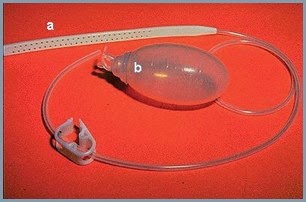Penrose drains are so last century.
Penrose drains are considered
“open” drains, which means they establish an open pathway from the wound to the
outside. They require bandaging to protect the drain and collect the drainage
fluid, and they allow ascending infection by wicking bacteria into the wound.
Penrose tubing is soft and collapsible. Drainage occurs mostly via the outside
of the tubing material and is prone to obstruction when the fluid is thick
and viscous.
Closed suction drains, such as the Jackson Pratt (J-P), are a
more effective method of wound drainage.
 |
| Jackson Pratt closed suction drain |
Negative pressure generated by the
drain reservoir (also called the “grenade”) actively pulls fluid out of the wound rather
than relying on passive drainage. The J-P tubing exits a location distant from
the wound and is secured with a purse string and Chinese finger trap suture,
preventing ascending bacterial contamination.
The J-P drain is composed of a soft, white, silicone
drain tube that is implanted into the wound. This is connected to clear tubing
that exits the wound and terminates in the reservoir. There are multiple sizes of tubing and
reservoirs. Negative pressure is generated by closing the reservoir cap while compressing it. Emptying the reservoir is simply done by opening the cap and pouring the fluid out. It does not have to be disconnected from the tubing to be emptied.
 |
| Implantation of a JP drain after removal of a large lipoma in a dog prior to closure of the incision. |
 |
| Same dog as above with J-P in place and secured with suture. The grenade has been compressed and the cap closed and fluid is being suctioned from the interior of the wound. |
 |
| Large ventral cervical bite wound in a pit bull dog. Initial therapy was with tie-over bandages. |
 |
| After several days of open wound management, closure was performed over a JP drain. |
Another advantage of the Jackson Pratt is that the amount of
fluid being produced by the wound can be quantified. This is especially helpful
when used for generalized peritonitis in dogs or cats. (1) (See https://drstephenbirchard.blogspot.com/2013/11/dehiscence-of-intestinal-incision-why.html).
J-P drains are more expensive than pen rose drains
but their effectiveness justifies the cost. They are available through amazon.com for about $10 per unit.
That’s a pretty small price to pay for such a versatile and effective drainage
apparatus.
References
When surrounded with love, seriously ill pets are more likely to survive. Read about this is Dr. Birchard's new book. Click here for more information.


No comments:
Post a Comment